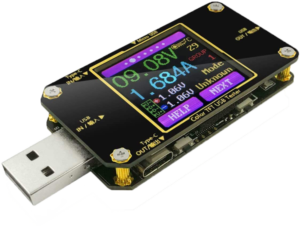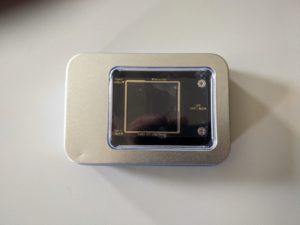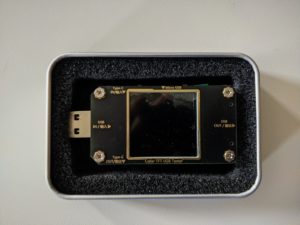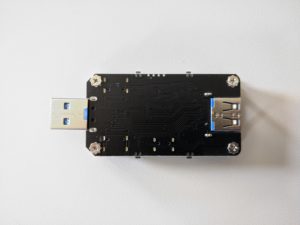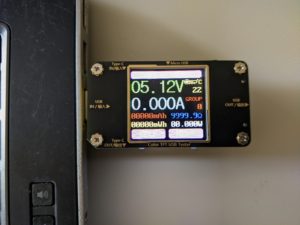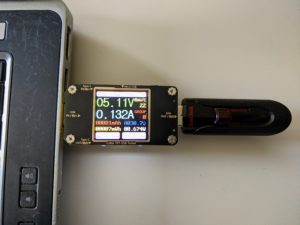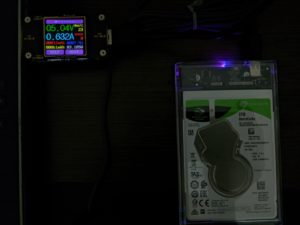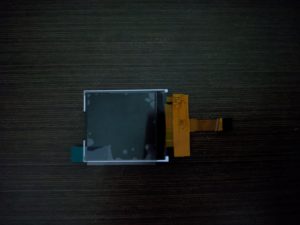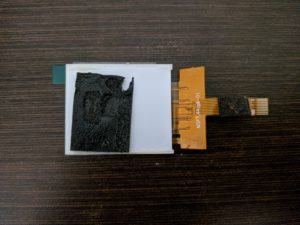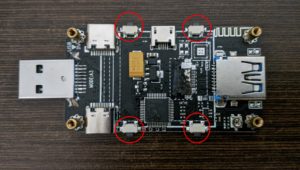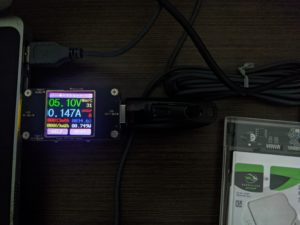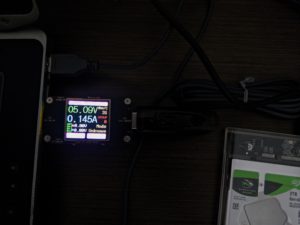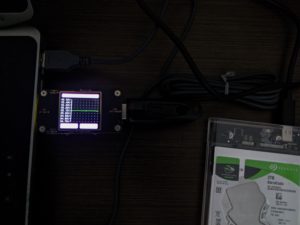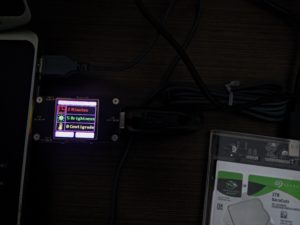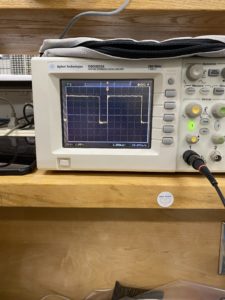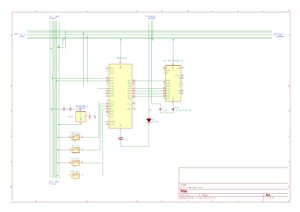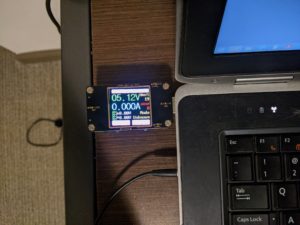MakerHawk USB Multimeter Dissection
Project for ECE6723 – Embedded Systems
Introduction
Personal Information
Why the MakerHawk USB Multimeter?
- In the past two years, I have used such devices extensively for measuring voltage and currents on various devices such as wireless gateways, Raspberry Pis and its modules as I needed to run them off a battery.
- This developed my interest in these type of devices and I believe it would be beneficial for the entire class to know more about such specialized multimeters.
- What really surprised me is that, even though not mentioned on the specification, all input and output ports can be used to transfer data at the same time, like a USB Multiport adapter.
Product market and retail info
The MakerHawk USB Multimeter, as the name suggests, is a multimeter for calculating the voltage and ampere drawn by USB devices.
The device has the following components:
- 1 x USB Type A male connector
- 1 x USB Type A female connector
- 2 x USB Type C female connectors
- 1 x MicroUSB Female connector
- 4 x SPST Mini pushbuttons to control the options on the LCD
- 1.44 inch color LCD display
Features
- Current curve range: 0-3A
- Voltage curve range: 4.5V-24V
- Input voltage: 4.5-24V/current: 0-3A
- Energy measurement range: 0-99999mWh
- Capacity measurement range: 0-99999mAh
- Load impedance measurement range: 1.5Ω-9999.9Ω
- Temperature Measurement Range: -10°C to 100°C/0°F to 200°F
- All ports can be used as input or output ports
- Type C ports support Qualcomm Quick Charge Technology 2.0 or 3.0
Product Histroy
Such products first started out as a dual port USB Type – A, male to female connectors. You could plug in a single USB Type-A device into it and know its power draw. However, as time went by, these products evolved and now support multiple types of USB ports (Type – A, Type – C and MicroUSB in case of the “MakerHawk USB Multimeter Dissection”) and can show different power draws for two of the devices attached.
MSRP and street-prices
- MSRP: $23
- Sold on: Amazon
- Manufacturer: MakerHawk
- UNSPSC Code: 26111700
Retail outlets and rebranded/OEM versions
This product is not available in Retail outlets, it can be only found online and their manufacturer’s official stores are on Amazon.com and their own website, MakerHawk.com.
There are no rebranded / OEM versions of this product. However, you can find similar types of products and there are loads of USB multimeters out there.
Photo Journals
Unboxing
Operational
Dissection
Product Operation
Human-machine interfaces
The device comes with 4 buttons along with a 1.44 inch LCD display. The top two buttons, when long pressed, rotate the display. The bottom right button is for switching to the next screen. The bottom left button displays the help section for each screen. Using the bottom right button, the windows can be cycled in the following order:
- Standard Multimeter (Shows voltage and ampere)
- Standard Multimeter + Mode
- Timer
- Paths in use + Resistence
- Voltage Graph
- Ampere Graph
- Settings
Usage Timing Diagrams
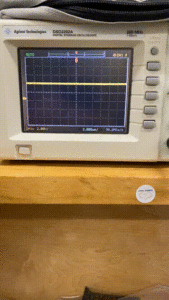 LCD Timing (The LCD has a high refresh rate, which is why the you can see the timings move really fast.)
LCD Timing (The LCD has a high refresh rate, which is why the you can see the timings move really fast.)
(Kindly click the image as it is a GIF)
Product Analysis
High-level product design diagram
Component-level schematics
Click to enlarge
The components were tiny and wires were too small to be deciphered. However, after using a microscope and mapping out each wire the schematic was fairly simple to understand.
Electrical BoM (including component costs breakdown)
| No | Part Number | Description | Quantity | Price | Link |
|---|---|---|---|---|---|
| 1 | STM8S005C6T6 | IC MCU 8BIT 32KB FLASH 48LQFP | 1 | $2.17 | https://www.digikey.com/en/products/detail/stmicroelectronics/STM8S005C6T6/3087896 |
| 2 | UJC-HP-3-SMT-TR | USB TYPE-C – Receptacle Connector | 2 | $0.99 | https://www.digikey.com/en/products/detail/cui-devices/UJC-HP-3-SMT-TR/12173295 |
| 3 | A-USB3 A-LP-SMT1 | USB TYPE-A – USB 3.2 Gen 1 Plug Connector | 1 | $1.75 | https://www.digikey.com/en/products/detail/assmann-wsw-components/A-USB3-A-LP-SMT1/2700522 |
| 4 | SS-52000-004 | USB TYPE-A – USB 3.2 Gen 1 Recp Connector | 1 | $1.50 | https://www.digikey.com/en/products/detail/stewart-connector/SS-52000-004/9921570 |
| 5 | ME6203A33PG | 3.3v Low dropout Regulator | 1 | $0.09 | https://www.aliexpress.com/item/4000806280540.html |
| 6 | 434121050816 | Flat Tactile Switch | 4 | $0.53 | https://www.digikey.com/en/products/detail/w%C3%BCrth-elektronik/434121050816/5225496 |
| 7 | 473460001 | Micro-USB Female Connector | 1 | $1.10 | https://www.digikey.com/en/products/detail/molex/0473460001/1782470 |
| 8 | 477J 7343 | 6.3V Tantalum Capacitor | 1 | $0.19 | https://www.aliexpress.com/item/1005002896577739.html |
| 9 | 5110 LCD | 1.44 Inch 128*128 Color TFT Red LCD Display (SPI) | 1 | $3.34 | https://www.aliexpress.com/item/32588475986.html |
| 10 | Ceramic Capacitor | SMD Capacitors | 8 | $0.05 | https://www.aliexpress.com/item/32859526036.html |
| 11 | FR107W | F7 SMD Chip Diode | 1 | $0.01 | https://www.diytrade.com/china/pd/20633748/FR107W_F7_F1M_SOD_123FL_RS07M_DFR1M_1A_1000V.html |
| 12 | MC74VHC1GT00DBVT1G | 5 PIN Logic Gate | 1 | $0.50 | https://www.mouser.com/ProductDetail/onsemi/MC74VHC1GT00DBVT1G?qs=vLWxofP3U2xJLVB8y9WlKA%3D%3D |
| $15.14 |
Non-electrical BoM (including material costs breakdown)
| No | Description | Quantity | Price | Link |
|---|---|---|---|---|
| 1 | Double Sided Copper Clad Laminate PCB Circuit Board 4X6 | 1 | $2.50 | https://www.amazon.com/Double-Sided-Copper-Laminate-Circuit/dp/B01LZV2BZM |
| 2 | Mounting Screw | 4 | $0.05 | |
| 3 | Manufacturing Cost (Approximate) | 1 | $1.50 | |
| $4.20 |
Profit = Selling Price – (Cost of Electrical Components + Cost of Non-Electrical Components + Cost of Manufacturing)
Profit = $23 – ($15.14 + $2.55 + $1.50) = $3.66
Reassembly
Reassembling the device was fairly easy. The LCD needed to be plugged back into the LCD Connector and the top plate had to be screwed back into place on the 4 mounting screws.
Lessons Learnt
- The USB BUS does not need to be powered individually for each connector as USB uses 4.75V to 5.25V in general. So it can be safe to power all the USB ports from a single input.

